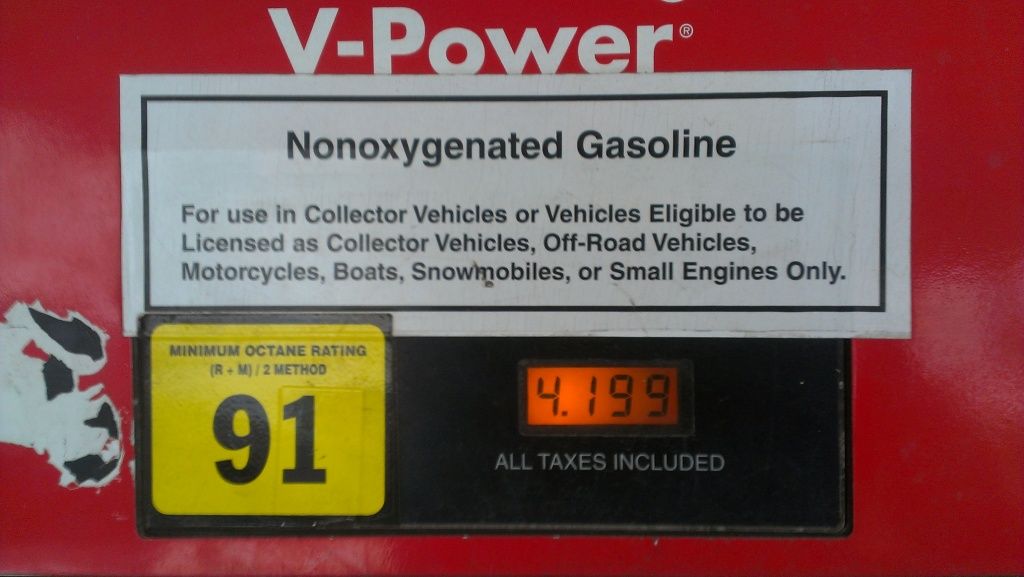I know this is somewhat a debateable topic but anyone else with experiance running Non-Oxy Fuel? This is my first tank in this car. I can also get 93 around town (reg fuel) so just trying to figure out what would be long term best for the car.


2017 Audi S8+ | 2021 Audi RSQ8 | 2021 Cadillac Escalade Sport Platinum | 2007 Porsche Turbo2021 Sea Ray 350 SLX | 2020 Polaris Ranger Crew XP1000 | 2022 Polaris Indy VR1 850/650
2017 Audi S8+ | 2021 Audi RSQ8 | 2021 Cadillac Escalade Sport Platinum | 2007 Porsche Turbo2021 Sea Ray 350 SLX | 2020 Polaris Ranger Crew XP1000 | 2022 Polaris Indy VR1 850/650
now: 2021 Mercedes AMG C63 S, 2017 Chevrolet Corvette Grand Sport
past: 2005 Audi S4, 2011 Audi S4
now: 2021 Mercedes AMG C63 S, 2017 Chevrolet Corvette Grand Sport
past: 2005 Audi S4, 2011 Audi S4
B7 RS4
2011 S4 Premium Plus 6MT, Sepang Blue Pearl, Black Silk Nappa, Sport Diff, B&O, B8.5 MMI 3G+ Nav, Ti Pkg
APR Stage 2+ Stock/93/100/Valet, Eurocode Alu Kreuz, Eurocode USS Sways + End Links, Eurocode Meisterwerk SSK, Roc Euro Intake, Apikol Rear Diff Mount, Fast Intentions Exhaust, Escort 9500xi, Laser Interceptor, P3 Vent Gauge, VCDS
Like a surgeon with a scalpel, my S4 is a precision instrument, with which I carve and dissect my way through traffic.
2010 S4 Prem+, Quartz Gray, S-tronic, Sport Diff, B&O, Nav, Gray Birch
StopTech ST-60 BBK - Stratmosphere intake - APR v2.2 Stage 2 w/pulley + exhaust, v2 Coolant System
Alu-Kreuz, Apikol rear diff mount, 034 transmission mount
2011 S4 Premium Plus 6MT, Sepang Blue Pearl, Black Silk Nappa, Sport Diff, B&O, B8.5 MMI 3G+ Nav, Ti Pkg
APR Stage 2+ Stock/93/100/Valet, Eurocode Alu Kreuz, Eurocode USS Sways + End Links, Eurocode Meisterwerk SSK, Roc Euro Intake, Apikol Rear Diff Mount, Fast Intentions Exhaust, Escort 9500xi, Laser Interceptor, P3 Vent Gauge, VCDS
now: 2021 Mercedes AMG C63 S, 2017 Chevrolet Corvette Grand Sport
past: 2005 Audi S4, 2011 Audi S4
2007 VW GLI - AWD Conversion, a diet and 600+HP coming soon - Racing @ 2014 Pikes Peak Hill-Climb
2011 Audi S4
Like a surgeon with a scalpel, my S4 is a precision instrument, with which I carve and dissect my way through traffic.
2010 S4 Prem+, Quartz Gray, S-tronic, Sport Diff, B&O, Nav, Gray Birch
StopTech ST-60 BBK - Stratmosphere intake - APR v2.2 Stage 2 w/pulley + exhaust, v2 Coolant System
Alu-Kreuz, Apikol rear diff mount, 034 transmission mount
now: 2021 Mercedes AMG C63 S, 2017 Chevrolet Corvette Grand Sport
past: 2005 Audi S4, 2011 Audi S4
Like a surgeon with a scalpel, my S4 is a precision instrument, with which I carve and dissect my way through traffic.
2010 S4 Prem+, Quartz Gray, S-tronic, Sport Diff, B&O, Nav, Gray Birch
StopTech ST-60 BBK - Stratmosphere intake - APR v2.2 Stage 2 w/pulley + exhaust, v2 Coolant System
Alu-Kreuz, Apikol rear diff mount, 034 transmission mount
now: 2021 Mercedes AMG C63 S, 2017 Chevrolet Corvette Grand Sport
past: 2005 Audi S4, 2011 Audi S4
|
© 2001-2024 Audizine, Audizine.com, and Driverzines.com
Audizine is an independently owned and operated automotive enthusiast community and news website. Audi and the Audi logo(s) are copyright/trademark Audi AG. Audizine is not endorsed by or affiliated with Audi AG. |

|
Bookmarks